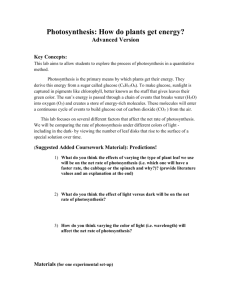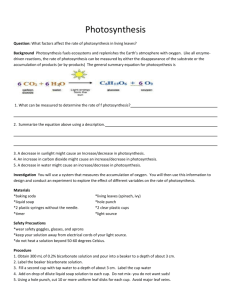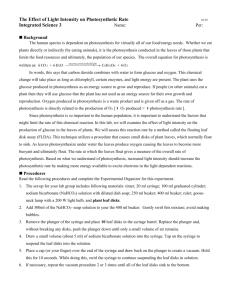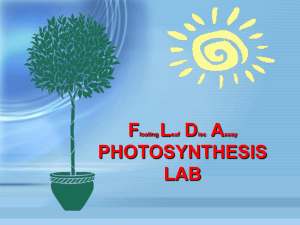Floating Disks Student Materials (Word Doc)
advertisement
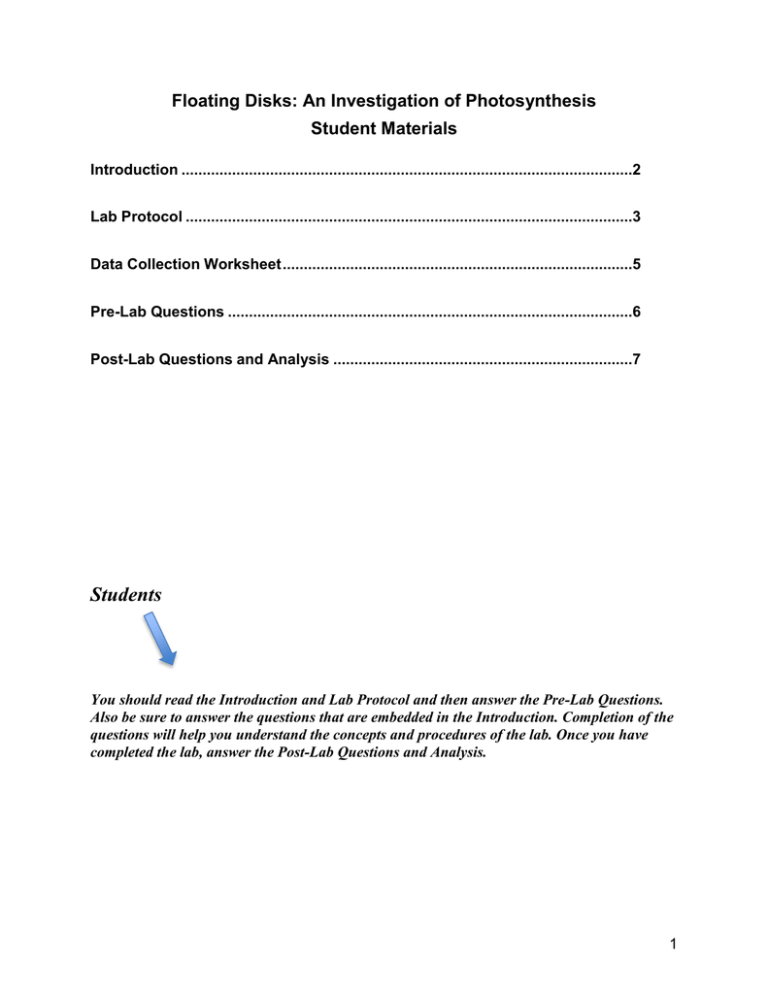
Floating Disks: An Investigation of Photosynthesis Student Materials Introduction ...........................................................................................................2 Lab Protocol ..........................................................................................................3 Data Collection Worksheet ...................................................................................5 Pre-Lab Questions ................................................................................................6 Post-Lab Questions and Analysis .......................................................................7 Students You should read the Introduction and Lab Protocol and then answer the Pre-Lab Questions. Also be sure to answer the questions that are embedded in the Introduction. Completion of the questions will help you understand the concepts and procedures of the lab. Once you have completed the lab, answer the Post-Lab Questions and Analysis. 1 Floating Disks: An Investigation of Photosynthesis Introduction Plants use the process of photosynthesis to convert light energy into glucose, a carbohydrate that plant cells use for food. Photosynthesis occurs in the chloroplasts of plant cells. For photosynthesis to occur, the energy from the sun needs to be trapped in special molecules. One such molecule is chlorophyll, which mostly absorbs light in the red and blue ranges of the visible light spectrum. Green light is largely reflected, which is why most plants are green. Photosynthesis can be divided into two parts, light dependent reactions and light independent reactions. During the light dependent reactions, sunlight excites electrons in chlorophyll and these high-energy electrons are used to make ATP. The high-energy electrons do not return to chlorophyll, but water can donate electrons to replace those lost. The process of losing electrons converts water to oxygen and H+. In the light independent reactions (also called the Calvin cycle), the ATP formed from sunlight provides the energy to make glucose from CO2. The overall equation for photosynthesis can be written as: 6CO2 + 6H2O + light energy C6H12O6 + 6O2 Look at the equation. Can you think of a way to measure the rate of photosynthesis? Write your ideas here: _____________________________________________________________ __________________________________________________________________________ __________________________________________________________________________ In this lab, leaf disks will be used to assay the rate of photosynthesis under various light conditions. The leaf disks will be put into a solution of baking soda (sodium bicarbonate, NaHCO3) and detergent. The baking soda is a source of carbon, and the detergent acts as a wetting agent that makes it easier for the solution to infiltrate the leaf disk. By using a syringe to create a vacuum, the gases in the intercellular air spaces (Figure 1) will be pulled out of the leaf disk. The gases are replaced by the baking soda/detergent solution. This makes the leaf disks denser than the solution and they should sink. As the cells in the leaf disks photosynthesize, the liquid inside the leaf will be replaced by oxygen gas. The gas will increase the buoyancy of the disk and it will float to the surface. Figure 1. Anatomy of a Leaf. Why do leaves float in water? __________________________________________________ __________________________________________________________________________ 2 Floating Disks: An Investigation of Photosynthesis Lab Protocol Materials 2–3 fresh young leaves or about 8 plant seedlings 2 5-cm sections of drinking straw 1 small container such as cup or 100-mL beaker 2 250-mL beaker 1 100-mL graduated cylinder 3 10-mL syringes baking soda/detergent solution (photosynthetic solution) water piece of aluminum foil, approximately 10 cm 10 cm Procedure Set up the syringes 1. Using the 100-mL graduated cylinder, add 35 mL of baking soda/detergent solution to the 100-mL beaker or small cup. (Note: your teacher may have done this for you already.) 2. As shown in Figure 2, use the straw to punch out 5 leaf disks. Important! Make sure you avoid the mid vein of the leaf. 3. Remove the plunger from the syringe and gently blow the disks out of the straw and into the syringe (Figure 3). Repeat steps 2 and 3 so that you have a total of 10 disks. Figure 2. Leaf punching technique. Figure 3. Technique for transferring leaf disks to syringe. Figure 4. Technique for “pulling a vacuum.” This process removes the gases from the intercellular spaces of the leaf. 4. Replace the plunger, being careful not to crush the leaf disks. 5. Draw 8 mL (or cc) of the baking soda/detergent solution into the syringe. 6. Invert the syringe (hold it tip up), and gently push the plunger up to remove the air. 7. Put your thumb over the tip of the syringe and pull the plunger, creating a vacuum that will pull the gases out of the leaf disk (Figure 4). Hold the vacuum for 5 seconds, tapping the syringe to see if the leaf disks sink. Remove your thumb and if there is air at the tip of the syringe, gently push the air out. 3 8. Repeat steps 7 and 8 until all the disks sink. Place the syringe plunger down in the 250-mL beaker while you prepare the other two syringes. 9. Repeat steps 3–10 to set up two additional syringes with leaf disks. Set up the experimental conditions and control: 10. Wrap one syringe with foil to block out all the light. Note any floating disks in the data table for Time 0. 11. Place the foil wrapped syringe and one other syringe plunger down in a 250-mL beaker and place the beaker very close to the light. Place the third syringe in a second beaker in ambient (room) light. Note any floating disks in the data table for Time 0. Collect data: 12. Check the syringes every five minutes and record the number of disks that have risen during each 5minute interval in the appropriate place in the data table provided on the data collection worksheet. 4 Floating Disks: An Investigation of Photosynthesis Data Collection Worksheet Name: Other group members: Class/period: Date: Time (minutes) Number of Floating Leaf Disks Bright light Ambient light No light 0 5 10 15 20 25 30 35 40 Observations 5 Floating Disks: An Investigation of Photosynthesis Pre-Lab Questions Directions: After reading through the introduction and protocol for the Floating Disks lab, answer the questions below. 1. Understanding What is the role of the baking soda in this experiment? 2. Remembering What is the purpose of an experimental control? 3. Applying Which syringe serves as the control in this experiment? Explain why you made this choice. 4. Applying Will the disks in each of the tubes behave the same? Explain your answer. 5. Understanding Why will the disks float to the top of the syringes? 6 Floating Disks: An Investigation of Photosynthesis Post-Lab Questions and Analysis Directions: After completing the Floating Disks lab, answer the questions below. 1. Analyzing In which tube did all (or most) of the leaf disks float first? Does this result match your prediction from the pre-lab questions? 2. Analyzing In general, you would assume that increasing the amount of light will increase the rate of photosynthesis. Explain why the increase in photosynthesis causes more disks to float. Does the data you collected support this assumption. 3. Creating If the leaf disks were boiled, what kind of result would you expect? Explain your answer. 7
